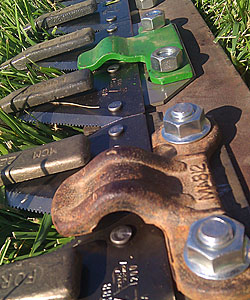Frequently Asked Questions
Can I put a sickle with bolt on sections into my machine, and what is the benefit of a bolted sickle?

In most circumstances bolted sickles can replace riveted sickles. The main problem that needs to be addressed is the taller height of the nut. Sickle nuts are generally cone shaped and average 5/16” to 3/8” tall. The hold down clips used on your cutter need to have a form with at least 3/8” of an inch clearance under the arch to allow for the nut. You can repair a riveted sickle with a bolt while the knife assembly is still in the machine, as long as the knife hold down clips have adequate clearance. The bolts used in sickle applications have a ribbed shoulder that is oversize to the rivet hole, they require a press fit and must be seated against the bottom of the sickle knifeback to work properly.
Typically bolted sickles are easier to maintain. In most applications nuts can simply be removed, the old section replaced, and nuts retorqued with minimal effort.
Can I replace the single malleable cast guards on my mower with forged double guards?

The answer is yes, in most cases. The forged double guard is a high performance version of a guard, compared to the cast iron single guard. Forged double guards typically have a much smaller “girth” which helps them slide thru and down tangled crops better.
From personal experience I can tell you if you are stopping five times an hour to unplug your cutter bar with single guards, switch to double guards and you can maybe drop that to once an hour, as well you may pickup an extra higher gear while mowing.
How do I tell if my sickle is worn out?
There are two main things to check for wear on a sickle:
1) Sickle section – depending on the type of section the following should be looked at starting with condition of the edge of the section. Check to make sure the edge is sharp, if you would not be afraid to run your finger along the cutting edge chances are the section is not sharp enough to mow hay. The section should be straight, not bent, and the bottom side of the section heel should not show wear.
2) Knifeback - should be straight and show no more than 1/16” wear across the back edge.
How do I tell if my guard is worn out?
Two areas should be checked for wear on a double guard.
1) The edge of the ledger surface should not show more than 1/16” wear, the edge should be worn sharp. A radius greater than a 1/16” indicates a worn guard.
2) The back edge, or wear bar on the guard should show no more than 1/16” wear on any flat. The wear bar helps hold the sickle forward, and supports the back of the section keeping the cutting edge of the section down on the ledger of the guard.
How Do I Rebuild a John Deere 600 Series Flex Head Cutterbar?
This video covers the steps and components needed to replace the sickle sections, hold-downs and guards on a 30-foot flex head cutterbar. It takes you through the process step by step, including checking for wear, replacing parts and troubleshooting.
